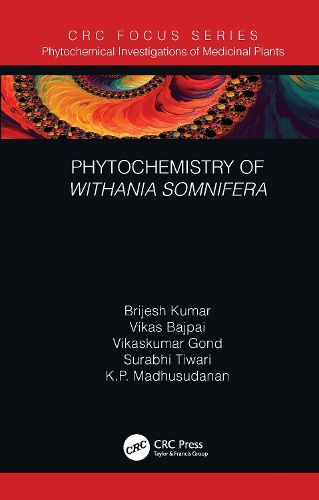Phytochemistry of Withania somnifera
Brijesh Kumar, Vikas Bajpai, Vikaskumar Gond, Surabhi Tiwari, K. P. Madhusudanan

Phytochemistry of Withania somnifera
Brijesh Kumar, Vikas Bajpai, Vikaskumar Gond, Surabhi Tiwari, K. P. Madhusudanan
Withania is a genus of the nightshade family of flowering plants distributed in the subtropical regions from the Mediterranean to South East Asia. Only two species, W. somnifera and W. coagulans, are found in India. The most common species is W. somnifera (WS), which occurs naturally in the subtropical regions from the Mediterranean through Africa to the Middle East, the Indian Continent, Sri Lanka, South East Asia, subtropical America and Australia. It is a perennial shrub that grows to 75 cm (.75 m) tall with tomentose branches, oval yellowish green leaves, orange red berries and a papery calyx, and it survives harsher climatic conditions. In Ayurveda it is believed the plants which survive harsh conditions have strong healing and tonification properties. The main bioactive phytoconstituents of WS are withanolides (steroidal lactones), alkaloids, flavonoids, sterols, phenolics and others. Among the various withanolides, withanolide A, withaferin A, withanone and withanolide D are the most abundant, having various activities. WS is a wonder herb with a broad spectrum of pharmacological properties, such as antioxidant, antidepressant, aphrodisiac, antiulcerogenic, antivenom, anti-inflammatory, antiarthritic, anticancer, antiparasitic, antimicrobial, anticancerous, antidiabetic, antitumor, hemopoetic neuroregenerative, immunomodulatory, cardioprotective, radio-sensitizing, rejuvenating, antistress, sedative, hypoglycemic, thyroprotective, adaptogenic, antispasmodic, immunomodulatory, immunostimulant and antiaging properties.
The simultaneous quantitative analysis of six major bioactive withanolides in five varieties of WS and in different plant parts (root, stem and leaf) of WS was accomplished. This method is also applicable to control the quality of commercially formulated products which contain WS bioactive compounds. Results indicated the WS variety NMITLI-135 showed the maximum abundance of withanolides at pH 8.5, EC-0.5 dS m?1, ESP-13 in sodic soil. Our results showed this readily available, rapid and reliable method is suitable for the routine analysis and effective quality control of raw materials and finished products.
FEATURES
Presents a collection of Ayurvedic features and scientific analytical and pharmacological evidence of important medicinal plants of Withania somnifera
Useful for natural product researchers, faculty, students and herbal product manufacturers
Uses advanced hyphenated techniques for assessing phytoconstituents
This item is not currently in-stock. It can be ordered online and is expected to ship in approx 2 weeks
Our stock data is updated periodically, and availability may change throughout the day for in-demand items. Please call the relevant shop for the most current stock information. Prices are subject to change without notice.
Sign in or become a Readings Member to add this title to a wishlist.


